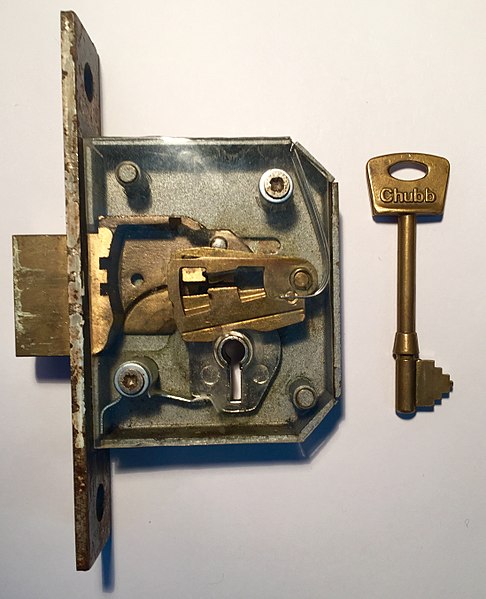Mortice lock

|
| A common lever-type mortice lock in the UK. |
Contents |
[edit] Introduction
A mortice lock (or mortise lock) is a lock that is carved or cut into a pocket on the side of a door or piece of furniture. This type of lock is sometimes used as a second lock for increased security and is commonly found in residential applications.
[edit] History
The mortice lock was commonly used in older buildings in the United States. Two of the country’s early presidents, Thomas Jefferson and James Madison both mentioned mortise locks as their security devices of choice. In 1788, Thomas Jefferson wrote to John Trumbull to request “mortise locks” on a carriage he wanted made to his specifications.
In 1798, James Madison included a reference to the devices (“mortise locks which I accordingly prefer”) in a letter to Jefferson. The letter followed with a review of matters of state. The discussion of locks came before the discussion of politics.
[edit] Operation
The locking body of a mortice lock is installed in the door, piece of furniture or other object while the box keep is installed in the facing frame. The mortice lock works by projecting its locking device (or lever) into the corresponding space on the facing side of the door frame or other object. A key is often used to operate the bolting mechanism and move it into the locked or unlocked position.
Mortice locks can create a layer of security on top of that which has been provided by standard cylindrical locks. Commonly available in deadlock and sashlock varieties, mortice locks are used in residential and commercial properties throughout the United States and Europe.
[edit] Related articles on Designing Buildings Wiki
Featured articles and news
Infrastructure that connect the physical and digital domains.
Harnessing robotics and AI in challenging environments
The key to nuclear decommissioning and fusion engineering.
BSRIA announces Lisa Ashworth as new CEO
Tasked with furthering BSRIA’s impressive growth ambitions.
Public buildings get half a million energy efficiency boost
£557 million to switch to cleaner heating and save on energy.
CIOB launches pre-election manifesto
Outlining potential future policies for the next government.
Grenfell Tower Inquiry announcement
Phase 2 hearings come to a close and the final report due in September.
Progress from Parts L, F and O: A whitepaper, one year on.
A replicated study to understand the opinion of practitioners.
ECA announces new president 2024
Electrical engineer and business leader Stuart Smith.
A distinct type of countryside that should be celebrated.
Should Part O be extended to existing buildings?
EAC brands heatwave adaptation a missed opportunity.
Definition of Statutory in workplace and facilities management
Established by IWFM, BESA, CIBSE and BSRIA.
Tackling the transition from traditional heating systems
59% lack the necessary information and confidence to switch.
The general election and the construction industry
As PM, Rishi Sunak announces July 4 date for an election.
Eco apprenticeships continue help grow green workforce
A year after being recognised at the King's coronation.
Permitted development rights for agricultural buildings
The changes coming into effect as of May 21, 2024.





















